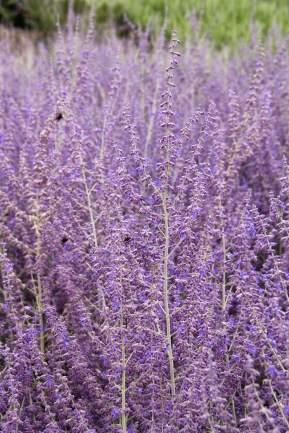 Admired for its silvery gray, fragrant foliage as much as its lavender-purple flowers, Russian Sage (Perovskia atriplicifolia) makes a bold statement in the garden. The abundant, spiky clusters of flowers bloom from late spring until autumn, almost completely obscuring the leaves. Russian Sage works well as a ground cover for open areas or as a specimen plant. It is deer and rabbit resistant, drought tolerant, low maintenance, and it attracts birds, bees and butterflies. It is a good plant to grow in containers and to use as cut flowers.
Admired for its silvery gray, fragrant foliage as much as its lavender-purple flowers, Russian Sage (Perovskia atriplicifolia) makes a bold statement in the garden. The abundant, spiky clusters of flowers bloom from late spring until autumn, almost completely obscuring the leaves. Russian Sage works well as a ground cover for open areas or as a specimen plant. It is deer and rabbit resistant, drought tolerant, low maintenance, and it attracts birds, bees and butterflies. It is a good plant to grow in containers and to use as cut flowers.
Russian Sage is a flowering herbaceous perennial plant and subshrub. Although not a member of Salvia, the genus of other plants commonly called sage, it is closely related to them. It has an upright habit, typically reaching 1.6–3.9 ft. tall, with square stems and grey-green leaves that yield a distinctive odor when crushed. It is best known for its flowers. Its flowering season extends from mid-summer to late October, with blue to violet blossoms arranged into showy, branched panicles.
Growing and caring for Russian sage plants is easy. It prefers very dry conditions, making it an ideal plant for xeriscaping. It is hardy in USDA plant hardiness Zones 5 through 10. Choose a location with very well-drained soil of average fertility in full sun. Although young specimens perform best when planted in a mixture of peat and either sand or perlite, Russian Sage can thrive in sandy, chalky, or loamy soil, or heavy clay soil with sufficient drainage. It can endure a wide range of soil pH.
 Set out new plants in early spring, spacing them 2 to 3 feet apart in a sunny location. Specimens planted in partially shaded locations tend to spread or flop, although this behavior can be controlled somewhat by pinching young shoots or by providing a strong-standing accompaniment that the plant can drape itself around for support. Flowers bloom only on new growth. Plants trimmed to (5.9–24.0 in.) in early spring provide the best subsequent growth and flowering. Water the plants occasionally during dry spells until they are established and growing. If you would like to apply mulch around the plants, gravel is a better choice than organic mulch because it allows better moisture evaporation. Overwatering and over-fertilization can damage its roots and lead to a rapid decline in health.
Set out new plants in early spring, spacing them 2 to 3 feet apart in a sunny location. Specimens planted in partially shaded locations tend to spread or flop, although this behavior can be controlled somewhat by pinching young shoots or by providing a strong-standing accompaniment that the plant can drape itself around for support. Flowers bloom only on new growth. Plants trimmed to (5.9–24.0 in.) in early spring provide the best subsequent growth and flowering. Water the plants occasionally during dry spells until they are established and growing. If you would like to apply mulch around the plants, gravel is a better choice than organic mulch because it allows better moisture evaporation. Overwatering and over-fertilization can damage its roots and lead to a rapid decline in health.
Russian Sage is frequently propagated by cuttings. Because its woody crown is resistant to division, softwood cuttings are taken from shoots near the base, generally in late spring. Hardwood cuttings selected in mid-to-late summer also provide a viable propagation technique.

